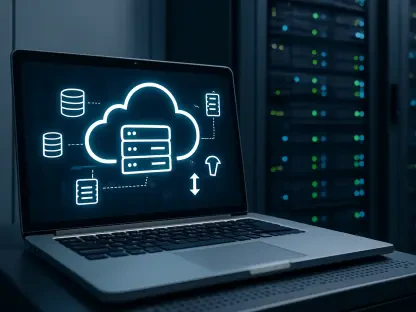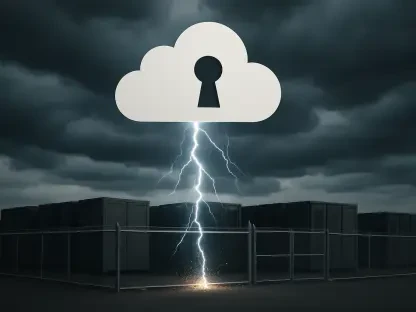In today’s digital age, enterprises and governmental entities grapple with the relentless threat of Distributed Denial-of-Service (DDoS) attacks. As technological advancements continue to evolve, so does the frequency and sophistication of these malicious intrusions. This has prompted urgent discussions on whether current protection measures are evolving sufficiently to counteract these growing cyber threats, with many organizations seeking to safeguard their digital infrastructure more effectively.
The Growing Challenge of DDoS Attacks
Increasing Frequency and Sophistication
Over the years, cybercriminals have intensified their assault on digital platforms through increasingly sophisticated DDoS attacks, causing significant disruptions to services worldwide. Leveraging advanced technologies, attackers have developed formidable methods to amplify their attacks, rendering traditional defense mechanisms inadequate. With these enhanced techniques, criminals are capable of exploiting vulnerabilities in systems that were previously deemed secure, challenging businesses to adopt more robust and dynamic security solutions. This increase in DDoS activity has spurred heightened awareness among companies and governments, emphasizing the need for innovative strategies to ensure uninterrupted service and safeguard valuable data.
Impact on Industries
Crucial sectors including Banking, Financial Services, and Insurance (BFSI), healthcare, and e-commerce are particularly vulnerable to DDoS attacks given their dependency on seamless service availability. Any disruption within these industries not only impairs operations but also jeopardizes consumer trust and loyalty. In the telecom sector, where connectivity serves as the backbone of operations, any compromise can lead to broader communication breakdowns affecting national infrastructure. The pervasive threat of DDoS attacks demands that these industries remain vigilant and continue investing in sophisticated protection mechanisms capable of mitigating the risks associated with service disruptions. By prioritizing security, these key sectors aim to uphold service integrity and maintain customer satisfaction.
Driving Forces Behind DDoS Protection
Digital Transformation as a Catalyst
The global push toward digital transformation forms a catalyst amplifying the vulnerability to DDoS threats. As businesses embrace digitalization, they inadvertently expand their attack surface, creating ample opportunities for attackers. The intensified connectivity across industries has necessitated robust cyber defense mechanisms to shield digital infrastructure. With sectors such as BFSI and healthcare increasingly relying on digital operations, the imperative to fortify security measures becomes more pressing. Companies are allocating substantial resources toward enhancing their cyber defenses to safeguard their operations against the relentless pursuit of cybercriminals eager to exploit these vulnerabilities. This pursuit of fortified defenses is not merely a matter of risk management but a strategic imperative in safeguarding organizational integrity.
Adoption of Cloud and IoT
The widespread integration of cloud computing and Internet of Things (IoT) technologies has revolutionized business operations, yet this evolution presents new security challenges. As enterprises increasingly migrate to cloud-based solutions and IoT devices proliferate, the attack surface broadens, exposing them to intricate security dilemmas. While these technologies offer unparalleled operational efficiencies, they necessitate advanced mitigation strategies to protect against unauthorized access and cyber threats. Given the sensitivity of data stored in clouds and transmitted via IoT, organizations must prioritize security protocols to ensure data integrity and shield against DDoS attacks. Companies are investing in cutting-edge technologies to monitor, detect, and respond to threats in real-time, ensuring resilience against the ever-evolving landscape of cyber threats.
Innovations in DDoS Protection
Role of AI and Machine Learning
Artificial Intelligence (AI) and machine learning technologies are playing pivotal roles in shaping the future of DDoS protection by unlocking faster threat detection and response capabilities. These advanced algorithms enable systems to adapt to evolving attack patterns with unprecedented efficiency, minimizing downtime and reducing false positives. By automating the process of threat identification and response, AI-driven solutions expedite the deployment of countermeasures in real-time, ensuring continuous protection of digital assets. As AI continues to evolve, the potential for creating robust security mechanisms increases, offering companies an edge in their fight against cyber threats. The integration of AI into DDoS protection promises to revolutionize the industry by enhancing accuracy and responsiveness to cyber threats.
Real-time Security Solutions
There is a burgeoning demand for real-time security solutions designed to offer comprehensive protection against high-volume DDoS attacks. These solutions are engineered to not only prevent downtime but also ensure continuous service availability. Businesses are keenly interested in deploying proactive measures that help anticipate threats and implement counteractions promptly. Such solutions leverage cutting-edge technologies to analyze patterns and trigger alerts before an attack escalates, providing a crucial line of defense for digital infrastructure. With the threat landscape continuously evolving, organizations require agile and responsive strategies capable of combating large-scale DDoS attacks efficiently, safeguarding their systems and minimizing operational disruptions.
Market Dynamics
Services Segment Growth
The services segment in the DDoS protection market is experiencing remarkable growth driven by an increased demand for expert support and tailored solutions. As threats become more sophisticated, businesses recognize the value of leveraging external expertise in managing and mitigating DDoS risks. Managed services offer companies the benefit of professional oversight with insights that enhance their security posture. These services include comprehensive monitoring, timely response, and risk management strategies, designed to help businesses adapt to evolving cyber threats. The reliance on specialized services stems from their ability to provide the necessary expertise to counteract the ever-shifting tactics employed by cybercriminals and ensure robust protection against potential intrusions.
Regional Insights
North America currently leads the DDoS protection market, thanks to stringent data protection regulations and a developed IT infrastructure that fosters advanced security solutions. The region’s emphasis on safeguarding digital assets through comprehensive cybersecurity frameworks provides a conducive environment for market dominance. Meanwhile, the Asia-Pacific region is witnessing rapid adoption of DDoS protection solutions as emerging economies prioritize digital security amid expansive technological growth. Countries within this region are capitalizing on innovative security technologies to mitigate the risks associated with increased digital integration, positioning themselves for substantial growth in the global DDoS protection arena. This dynamic illustrates the global recognition of the importance of robust cybersecurity measures tailored to regional needs and market conditions.
Challenges Facing DDoS Protection
High Implementation Costs
The financial implications associated with implementing comprehensive DDoS protection solutions present a significant barrier for many businesses, particularly small to medium-sized enterprises. These costs can be substantial, stretching budget allocations and competing with other priorities within organizations. While many recognize the potential risks and the necessity of securing their infrastructure, the investment required remains daunting, prompting some to delay adoption. Companies must weigh the immediate financial burden against the longer-term benefits of sustained protection, emphasizing the need for cost-effective solutions that provide robust security without extensive financial outlay. Finding innovative ways to reduce implementation costs while delivering effective protection is paramount to encouraging broader adoption among budget-conscious enterprises.
Evolving Cybercriminal Techniques
Cybercriminals continuously refine their techniques, developing new strategies that require timely updates to existing security measures. This ever-evolving approach necessitates constant vigilance and adaptation from vendors who are tasked with keeping their solutions relevant and effective. The challenge for security providers lies in anticipating emerging tactics and swiftly adapting their products to offer comprehensive protection. This requires continuous innovation and investment, enabling companies to respond proactively to threats before they manifest into disruptive attacks. Failure to maintain flexibility in security solutions could compromise an organization’s defense against sophisticated intrusions aimed at exploiting vulnerabilities within its systems.
Limited Awareness and Expertise
In various regions, especially among smaller enterprises, a lack of awareness and technical expertise hampers the effective adoption of DDoS protection solutions. This gap in understanding limits the widespread implementation of essential protective measures, leaving systems vulnerable to attacks. Overcoming this obstacle involves dedicated efforts to enhance education and raise awareness surrounding the importance of cybersecurity. By closing the knowledge gap, companies can better equip themselves with the tools and strategies necessary for effective defense. Initiatives aimed at fostering engagement and providing learning opportunities help bridge this divide, empowering businesses to pursue a proactive approach to safeguarding their online assets from DDoS threats.
Competitive Landscape
Key Industry Players
Prominent companies in the DDoS protection arena, including Cloudflare, Akamai Technologies, and Radware, are pioneering innovative security solutions designed to tackle these cybersecurity challenges head-on. These organizations are leveraging cutting-edge technologies such as AI and machine learning to refine their offerings, ensuring enhanced detection and mitigation of threats with minimal human intervention. As they continue to push the boundaries of technological advancements, these players play a significant role in shaping the competitive landscape of DDoS protection. By leading with innovation, they set the standard for the industry, driving progress and prompting peers to explore novel strategies that enhance security effectiveness.
Customizable, Cloud-based Solutions
Established companies alongside emerging startups are focusing intensely on developing customizable, cloud-based solutions to cater to the diverse needs of businesses. These solutions are tailored to provide scalable and affordable protection specifically designed for small and medium enterprises, offering flexible options that can adapt as organizational needs change. By providing versatile solutions accessible to businesses without extensive budgets, these companies are closing the gap between security requirements and available resources. The emphasis on customization ensures businesses receive protection that aligns seamlessly with their operational models, guaranteeing security without compromising on functionality or cost-efficiency. This approach underscores the importance of delivering responsive, market-driven solutions in the competitive landscape.
Recent Developments and Innovations
Strategic Expansions
Recent strategic expansions by companies such as NetScout and Akamai Technologies signify the industry’s commitment to enhancing DDoS mitigation capabilities. By expanding their mitigation networks, these companies aim to bolster security measures and encompass broader geographic reach. Initiatives such as the establishment of scrubbing centers are indicative of the proactive steps taken to improve service delivery and fortify defenses against DDoS threats. These strategic expansions reflect an industry-wide push to bolster cybersecurity infrastructures, ensuring companies remain ahead in safeguarding digital assets. Expansions serve as essential components in adapting to an environment where cyber threats continually evolve, offering enhanced resilience for businesses seeking robust protection.
Collaboration and Service Agreements
Collaboration and service agreements between industry players and organizations are vital for advancing cybersecurity efforts. By uniting resources and expertise, these collaborations enhance the capability to identify and respond to threats effectively. Joint ventures and partnerships help in pooling technological advancements, creating comprehensive solutions that keep pace with the fast-evolving threat landscape. Through shared knowledge and integrated strategies, companies foster resilience against sophisticated cyber-attacks, emphasizing the importance of collective defense in the realm of digital security.









